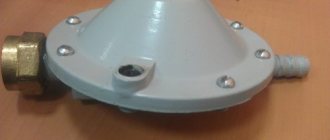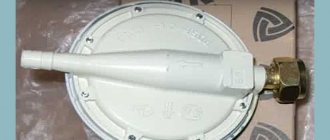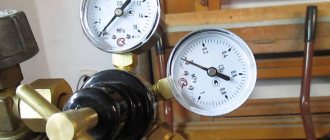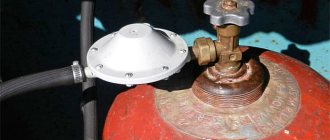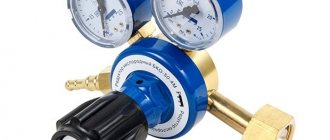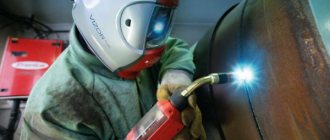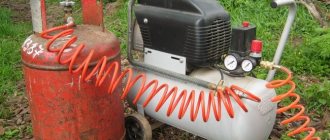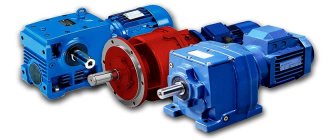Review of rubber boats
December 19th
Review of frog pumps for rubber boats
The frog pump has become popular due to its ease of use, portability, and ability to be used in the absence of a network. This type of pump is included in almost all rubber boat configurations. “Frog” belongs to the budget price segment, is sold separately and, with careful use, lasts for more than one year. On the market, “frog” foot pumps take second place in sales after electric compressors.
Pressure regulators for liquefied gases “frog”: everything from operating principle to choice
A gas reducer is an essential element of the gas supply system, well known to everyone who uses autonomous sources due to the lack of connection to a centralized main line. Regardless of its modification, the device takes on two functions simultaneously. It lowers the pressure and automatically maintains it at the required level at any intensity of gas consumption for stable and correct operation of the equipment - stove or heating boiler.
Propane in cylinders is at a pressure of 1.6 MPa or 16 bar. Typical operating requirements for consumer equipment range from 0.02 to 0.036 bar. Connecting directly is fraught with serious consequences, so purchasing and installing a gearbox is a safety issue and the very case when you should not skimp on small things.
Precautionary measures
Household gas is very dangerous. The main threats posed by propane are:
Reminder about domestic gas
- Fire hazard.
- Unsuitable for breathing.
- Explosion hazard when the maximum concentration of propane in the air is reached, as well as when the temperature in a closed volume rises sharply.
- During a gas leak, the temperature drops sharply and frostbite is possible.
To preserve the life and health of people and their property, precautions should be taken:
Rules for using gas
- Avoid proximity to open flames and heat sources.
- Avoid the presence of other flammable materials in the work area.
- Eliminate the presence of nitrates and perchlorates near gas equipment due to their chemical activity.
- Do not use the reducer for a propane cylinder if it is damaged or leaking.
How the frog gas reducer works and works
The RDSG-1 gearbox for connection to a valve or “frog” is widely used for domestic purposes. The popular name is due to the shape of a wide body with a thickening in the center. The operating principle is similar to the circuit implemented in the float chamber.
RDSG-1 is a direct-acting static device, optimal for use in dead-end systems with gas extraction by the end user.
The main structural parts are a tuning stabilizing spring, a working diaphragm and an inlet valve on the rod. At pressures below the nominal pressure, the force from the spring is transmitted to the membrane, which holds the valve in the open position for gas to pass through. When the pressure increases, the membrane, as a sensitive element, acts on the spring, which increases the compression ratio and closes the valve.
The traditional frog gas reducer has a small throughput and a narrow output pressure range without the possibility of adjusting it. Analog devices of foreign manufacture can be equipped with pressure gauges and a mechanism for regulating the level of output pressure, which has a large interval.
Direct gas equipment
Gas enters the high-pressure chamber through the fitting and acts on the valve to open it. The reducing valve is pressed against the seat by means of a locking spring, thereby preventing access to high pressure gas.
The purpose of the membrane is to remove the reducing valve from the seat and provide access for high pressure gas to the working (low) pressure chamber. That is, two directly opposite forces act on the membrane.
On one side, a pressure spring presses on the membrane through a pressure screw to open the pressure reducing valve. And from the gearbox chamber (from the inside) low pressure gas acts on the membrane.
When the pressure in the working chamber decreases, the pressure spring straightens, the valve moves away from the seat and a new portion of gas enters the chamber.
Comparative table of pressure regulators from different manufacturers, type RDSG-1
| Model | Inlet pressure | Outlet pressure | Gas consumption | Availability of adjustment | Availability of pressure gauge |
| RDSG 1-0.5 Belarus | 0.07-1.6 MPa | 2000-3600 Pa | 0.5 m3/hour | No | No |
| RDSG 1-1.2 | 0.07-1.6 MPa | 2000-3600 Pa | 1.2 m3/hour | No | No |
| Milano under eyeliner | 0.03-0.75 MPa | 1960-5880 Pa | 1.5 m3/hour | Yes | No |
| Milano under the sleeve | 0.03-0.75 MPa | 1960-5880 Pa | 1.5 m3/hour | Yes | No |
| Italy 694 | 1.6 MPa | 2900 Pa | 1.5 m3/hour | No | No |
| Italy 694 d/composite cylinders | 1.6 MPa | 3700 Pa | 1.5 m3/hour | No | No |
| RDSG 1-1.3 China | 0.07-1.6 MPa | 2000-3600 Pa | 1.3 m3/hour | No | Yes |
| RDSG 1-0.5 China | 0.07-1.6 MPa | 2000-3600 Pa | 0.5 m3/hour | No | Yes |
| GOK EN-61 | 1.6 MPa | 3700 Pa | 1.5 m3/hour | No | No |
| GOK for composite cylinders | 1.6 MPa | 2900 Pa | 1.5 m3/hour | No | No |
For normal operation of the equipment, the throughput or gas flow rate of the reducer must be 15-20% higher than the maximum consumption per hour.
The Trio-service company offers the best selection of household pressure regulators.
Source
Required pressure and volume
The key characteristics of a gas reducer are inlet pressure, operating pressure and flow rate, or the maximum volume of gas passing through the device in an hour.
The inlet pressure is determined by the standard pressure in the cylinders and is usually 20 MPa.
Technical characteristics of gearboxes
The operating pressure for household unregulated gas reducers is set at 0.3 MPa ±5%
For adjustable semi-professional and professional adapters, the operating pressure is set by the user in the range of 0-0.4 MPa, and for certain high-performance models - up to 1.6 MPa
The consumption volume must exceed the volume consumed by the device (or group of devices) per hour.
Malfunctions. Repair.
If you decide to carry out repairs or adjustments yourself, make sure you have the necessary qualifications. Poor repair of gas equipment can cause a fire, explosion or poisoning. After completing the work and assembly, make sure that the device is tight and operates correctly. The tightness is checked by applying a soap solution to all joints. No bubbling indicates there is no leak. But you shouldn’t delude yourself. The tightness will need to be checked several more times (after a day, three days, a week of operation), and then checked regularly, since a leak may occur some time after the start of operation.
Main malfunctions: the gas pressure at the outlet does not correspond to the nominal value (reason: the spring is broken or deformed), gas leakage (reasons: the membrane is damaged, the tightness of the connection between the membrane and the housing is broken, the float valve is leaking)
Here is a selection of materials:
Everything you need to know about heating and climate control Features of the selection and maintenance of boilers and burners. Comparison of fuels (gas, diesel, oil, coal, wood, electricity). Do-it-yourself ovens. Coolant, radiators, pipes, heated floors, circulation pumps. Chimney cleaning. Conditioning
If the float bypass valve leaks, then the leak may not occur in the reducer itself, but somewhere further, for example, in a gas stove, since in this case, in zero consumption mode (when the stove or some other consumer is turned off), at the outlet reducer and gas pipes, the pressure can reach the inlet pressure. Gas gradually leaks through the valve, and there is nowhere for it to go. If there is a gas cylinder at the inlet, the pressure can reach 15 bar, which is 500 times higher than the nominal one. Such pressure will definitely lead to leakage. At the same time, it is difficult to detect this malfunction, since when the stove is turned on, the pressure normalizes. There is no sign of overpressure (flame blowout). The fault can only be identified by measuring the outlet pressure in zero consumption mode. It can be no more than 20% more than nominal.
Conversion to a different pressure
Sometimes it becomes necessary to obtain non-standard pressure at the outlet. For example, having bought a stove for natural gas, I wanted to convert it to a bottled one. The usual way is to replace the injectors and low gas flow screws, but there is another way - to use a 12 mbar reducer. Such reducers are commercially available, but they are rare and difficult to buy. You can remake the usual one.
I will say right away that not every reducer can be converted to any pressure. There are the following restrictions. The ratio of the areas of the membrane and the inlet port, multiplied by the rocker arm, should be one and a half times greater than the ratio of the maximum inlet pressure and outlet pressure. Otherwise, the force developed by the membrane under gas pressure will not be enough to reliably close the inlet valve. In practice, it is usually easier not to carry out these calculations, but to configure the gearbox experimentally. All the same, to carry out calculations it needs to be disassembled in order to measure the area and lever of the rocker arm.
For remodeling, it makes sense to buy a gearbox in which the mounting screws are accessible and not covered in paint. The modification comes down to changing the elasticity of the spring. Let's disassemble the gearbox. If the pressure needs to be made less than it was, then shorten the spring a little (by half a turn), if more pressure is needed, then place a spacer between the gearbox housing and the spring. When installing the gasket, be careful not to block the hole in the housing. We assemble and check the gas pressure at the outlet. Repeat until the desired pressure is achieved. If after the next shortening the pressure turns out to be less than necessary, then the spring can be stretched a little or a gasket can be placed.
If it turns out that the outlet pressure is too high, even in the complete absence of a spring, then the relationship described above is not observed. The selected reducer cannot be converted to the required pressure.
When the elasticity is selected, you need to finally assemble the gearbox by applying silicone sealant between the bottom of the housing and the membrane.
Unfortunately, errors are periodically found in articles; they are corrected, articles are supplemented, developed, and new ones are prepared. Subscribe to the news to stay informed.
Hello. For a household gas stove, I bought a 27 liter reserve cylinder and filled it with 20 liters of propane. I connected it to try, turned on the burner, and after about 10 - 20 seconds a smooth, rather loud hum of the gearbox began. This never happened with the old cylinder. Question: is this dangerous, can the stove be used? Is this a gearbox or cylinder problem? Read the answer.
Hello. I have a similar question (Should gas come out of the upper chamber through the holes in RDSG 1-1.2?), I get it when the cylinder valve is opened (it’s like zilch). When the valve is closed, no bubbling is observed on the cylinder, but when the valve is open and the stove is burning, bubbles constantly come from the hole in the top cover. Is this normal? During disassembly I found a leak Read the answer.
Sequence of installation and use
A propane reducer of any type and design is considered a high-risk technique, therefore, when installing it, a number of mandatory requirements must be observed:
- The room (if the gearbox is mounted to an internal consumer) is thoroughly ventilated. Moreover, the window/vent must remain open throughout the entire duration of the initial start-up.
- The correct sequence for using the device is as follows: first, the valve on the propane cylinder opens smoothly. Then the valve of the reducer opens and only then the valve of the gas-consuming equipment. By rotating the adjusting screw handwheel, the required level of operating pressure is set. Disabling is done in reverse order. When extraneous sounds appear - clicks, hissing, etc. - the equipment is immediately turned off.
- After establishing a stable flow of gas through the reducer, monitor the readings of the pressure gauge needle, which should not deviate more than the pressure fluctuation values indicated in the passport. Otherwise, the use of the technology is stopped. A slow increase in gas pressure is considered especially dangerous.
- Once every 2...3 months, the tightness of all connections is checked, and if necessary, the threaded fasteners are tightened.
- If routine maintenance of the propane reducer is necessary - purge the valve - the device is disconnected from the gas main, after which the remaining gas is released from all working cavities of the device. All subsequent operations are performed only in special workshops that have test benches.
- After finishing use, the inlet valve on the gearbox is closed all the way. In this case, the binding of the spring is eliminated, and its performance increases.
- To comply with fire safety rules, it is advisable to provide flame extinguishing devices between the gearbox and the gas-consuming installation.
https://youtube.com/watch?v=lspIr9UNH7E
The use of bottled gas requires a thorough approach to ensuring safety and ease of use. We propose to consider the simplest example of connecting a propane cylinder to a gas stove: connection diagram, shut-off and control valves, organization of storage conditions.
Read also: Veroshpiron capsules 100 mg 30 pcs
What is the working principle of the frog gas cylinder reducer?
Preferably in detail and with a picture. The principle of operation of a cylinder gas reducer (“frog”) is clear from the schematic diagram presented in the figure. Other pressure regulators that ensure constant flow of gas media are designed in a similar way. They differ only in the design form of the parts, the presence or absence of regulatory elements.
The gearbox consists of a housing 1 and a cover 2, between which a round elastic membrane 3 is clamped. On the side of the cover, the membrane is loaded with a spring 4. In the center, the membrane is also clamped by two washers 5 with a rod 6 interacting with a rocker arm 7 swinging on a hinge. At the other end of the rocker arm there is valve 8, closing the inlet 9 of the gearbox.
At the required or lower gas pressure under the membrane, the spring through the rocker arm completely opens the valve and gas flows freely through the inlet pipe into the outlet 10. When the pressure rises above the nominal value, the membrane compresses the spring and closes the valve through the rocker arm. The amount of pressure required to close the valve is determined by the area of the diaphragm and the compression force of the spring.
The cover can be equipped with an adjusting screw to change the degree of compression of the spring, which allows you to regulate the amount of gas flow. There are also gearbox designs in which the space between the cover and the membrane is filled with an inert gas, which ensures the elasticity of the membrane, which makes it possible to do without a spring.
What is a propane reducer?
The design of all propane reducers is very similar. They all have:
- Sealed housing made of aluminum, brass or plastic.
- Inlet pipe for connection to the cylinder.
- Outlet pipe for connection to the consumer.
- High and low pressure chambers.
- Flexible membrane.
- Valve and stem.
- Return spring.
- Working spring.
In professional gas reducers, a pressure gauge, an adjusting screw or flywheel, and a threaded connection of the supply pipe are added to the design. The gearbox housing has a cylindrical shape, which is due to the use of a round membrane that bends inside the operating pressure chamber. The inlet and outlet pipes protrude from the housing.
Design and operation scheme
The fundamental design of all gearboxes is similar. The weight and size characteristics of the components, their design features, etc. may differ. The operating pattern is similar to that observed in the float chamber.
In the cavity of the housing, which has inlet and outlet pipes, there is a membrane between two washers, balanced on top by a spring resting against the plane of the body, and on the bottom by a rocker arm pivotally connected to the inlet valve. At low pressure, the spring exerts enough force on the diaphragm that it holds the inlet valve open, allowing gas to pass through the device with virtually no resistance.
High pressure gas reducer diagram
When the pressure rises to a certain threshold value, the membrane begins to compress the spring, simultaneously covering the inlet valve with a rocker arm. The level of pressure required for these actions is determined mainly by the following parameters:
- membrane dimensions;
- spring characteristics;
- the force required to perform the work of closing the valve.
In this case, the propane reducer can be equipped with a mechanism for adjusting the operating pressure within certain limits, or manufactured without it (“frog” is an example of an unregulated option). Products designed to work as part of an automotive system are also customizable (methane ones usually have one regulator, propane ones have one or two).
The supra-membrane part of the housing may have an opening at the top and thus communicate with the environment. There are also sealed models. They lack a hole and a spring, and instead of the latter, the cavity is filled with gas, which ensures equilibrium with its pressure. Combination products are also available.
Here, the pressure of methane flowing through the reducer (for example) is regulated simultaneously by the influence of both the spring and the gas. The hole at the top in such gas trains performs the function of feedback. It connects the product to the volume into which the gas is directed, thus establishing the dependence of the pressure in the reducer on the pressure in the volume (i.e., the supply is proportional).
Specifics
As already noted, gearboxes can be domestic and industrial. Also universal models.
Consumer versions may not be customizable.
These are simple models. They are used in everyday life and outdoors. RDSG products are installed together with household gas cylinders. They have a very simple design. Due to this, gas can only be used in household stoves. These products are inexpensive and very reliable. There is also a Frog type gearbox, there is the RDSG-1 model. They should only be used in cylinders with a volume of 12 - 50 liters.
The class of universal, customizable gearboxes has a more complex design and greater potential. This is an excellent option for domestic use and for work in the home workshop. The products are attached to the cylinders using a threaded method and are fixed securely.
They have a pressure gauge and an adjustment screw that allows you to vary the functional pressure within the range of 0 - 0.3 MPa. Their highest throughput capacity is 5 m3/hour.
The category of professional models is created from the best wear-resistant materials. They have the highest build quality and settings: 0.4 - 1.6 MPa.
Some modifications have two pressure gauges. They reflect input and functional pressure.
Often, many summer residents and hikers ask questions such as: is a reducer needed for a gas burner? And is a gearbox needed for a gas stove in the country? Stable and safe operation of any gas appliances and in any conditions is always necessary. Even if there is no urgent need for gearboxes, it won’t hurt to be on the safe side. It remains to decide which gearbox is needed for the gas stove.
Since the stove and burner are propane based, a propane reducer is needed. You need to select these products by studying them and comparing their characteristics. The key ones are:
- Purpose of the device.
- Higher inlet pressure.
- Functional pressure.
- Higher gas consumption.
- Attachment method.
- Planned operational life.
- Price.
For example, if you plan to connect a desktop portable stove only on weekends, the gas consumption according to your calculations is 5 liters per month, then you need a 5 liter capacity and a Baltika RDSG-2 reducer.
For a static stove with an oven, a capacity of 27 or 50 liters is required. A suitable gearbox is the Frog RDSG-2.
Questions often arise here - what does a Frog gas reducer actually do? Why is it named like that? What is its purpose?
Why do you need a frog gas reducer? Its functions, like those of other gas reducers, are pressure stabilization, safety, etc.
Why frog? This device is direct. In it, gas flows through a fitting. The valve opens and is pressed against the seat by a spring. High pressure gas does not penetrate into the chamber. The diaphragm displaces the valve from this seat. The pressure gradually decreases to the operating values of the device to which the reducer is mounted.
The spring straightens. The valve is detached from the seat and does not interfere with gas flow. As the pressure increases, the spring presses the valve again, gas does not flow. This principle is reminiscent of frog jumping. And the device is similar in shape to it.
If it is necessary to connect a composite container to a thermal umbrella, it is better to use imported products with a KLF connector
The professional model BPO 5-3 Krass is optimally suited for gas welding in a home workshop. It guarantees a flow rate of a maximum of 5 m3 per hour and allows you to adjust the operating pressure to 0.4 MPa. And for this task it has a flywheel and a pressure gauge. Thanks to the latter, it is possible to scrupulously assign pressure to the needs of gas welding equipment.
The device of the frog gas reducer, its specific differences
A frog for a gas cylinder is one of the most common types of gas reducers.
A gas cylinder reducer is a pressure stabilizer and is often an indispensable part of gas equipment. The pressure in a gas cylinder is not a constant value and depends on many factors, such as the fullness of the cylinder and its temperature, the type of filler gas and others. For normal operation of most devices, a certain set pressure is required. To match the gas pressure at the outlet of the cylinder and the pressure at the inlet to the device, a gas reducer is used. Gas reducers differ in the following indicators:
- highest throughput;
- the highest gas pressure at the inlet to the device;
- highest operating pressure at the outlet;
- according to the type of gas for which it is intended.
How to choose a reducer for a household propane cylinder
To select a propane reducer for a gas cylinder, it is necessary to study and compare their characteristics. The most significant are:
- Purpose.
- Maximum inlet pressure, kg/cm3.
- Working pressure, kg/cm3.
- Maximum gas consumption, m 3 /hour.
- Connection standard.
- Planned service life.
- Price.
Depending on the planned application and the planned type of cylinder, one or another model may be the best choice. So, for example, if you plan to connect a tabletop gas stove in a garden house that you visit on weekends (or take it on a boat trip) and estimate your monthly gas consumption to be five liters, a five-liter cylinder and a Baltika RDSG-2 gas reducer are best suited.
How does a frog fit on a gas cylinder?
The frog reducer for a gas cylinder has a structure typical for this type of device. The operating principle of the gearbox is based on the counteraction of the pressure of the membrane and the spring. Depending on the spring and diaphragm characteristics, gearboxes will have different inlet and outlet pressures and therefore different applications.
Some types of gearboxes may have an additional device for adjusting the pressure level in the gearbox, but the “frog” is not equipped with these parts and is an unregulated gearbox.
Gearboxes of this type are widely used due to their simplicity and reliability, as well as low price. They are required to be equipped with propane cylinders for household use; they are included in automotive gas and gasoline equipment, heating and welding equipment, as well as in industry and production.
How to set up a frog gas reducer? Is the frog reducer for a gas cylinder repairable?
To set up and adjust the frog gas reducer, you need certain skills and experience. Without proper qualifications, it is undesirable to perform such procedures, as this may negatively affect the stability of the device, its reliability and safety. After setting up the gearbox, it is necessary to check its tightness and regularly monitor it subsequently.
The consequence of a breakdown or incorrect adjustment of the gearbox is the occurrence of a leak. The cause of depressurization of the device may be failure of the membrane, valve or spring.
Only a dismountable, leaking frog reducer for a gas cylinder can be repaired. In this case, it is possible to both replace damaged parts and adjust them using gaskets. However, often the resulting effect will not last long and will not be worth the effort.
Changing to a different pressure
To adjust the frog to your parameters, certain skills and experience are required. The device must be disassembled; for this reason, sealed gearbox models are not suitable for reconfiguration or repair.
To adjust the pressure, you can replace the spring or place a gasket between it and the body. The spring can also be stretched a little. The damaged membrane is replaced.
After the required elasticity ratios have been selected, sealant is applied and the gearbox is put back together.
Reducer RDSG 1-1.2: tech. Specifications, Precautions and Installation Procedures
The gas cylinder is filled with propane - butane gas mixture. When producing a gas mixture, impurities remain in it, which make the gas supply unstable. The RDSG 1-1.2 reducer provides automatic adjustment and stable supply of gas from the cylinder to the consumer.
The role of the consumer is a gas-powered device. It could be:
- kitchen gas stove;
- welding machine;
- gas burners, etc.
This article describes what the RDSG 1-1.2 gas reducer consists of and the principle of operation.
Area of application of devices
Wherever there is no stationary gas distribution, people use propane in cylinders. And each cylinder is connected to one or another reducer. The most popular applications are:
Using the gearbox for soldering and welding
- Household and portable stoves and grills.
- Gas water heaters and heat guns for heating rooms.
- Thermal umbrellas for heating recreation areas.
- Gas cutters and welding torches.
- Fuel for land and river transport.
In many countries, wide gas distribution networks have been created to ensure recharging and delivery of gas cylinders to consumers.
The gas cylinder reducer ensures safe and stable operation of gas consuming devices.
If you find an error, please select a piece of text and press Ctrl+Enter.
Liquefied gas, which is used to fill cylinders for subsequent use, is always under increased pressure. To lower it, it is necessary to install a special type of shut-off and distribution valves on the cylinder - a propane reducer. Subsequently, the reducer automatically maintains the specified level of gas pressure. According to safety regulations, the device is always painted bright red - the same color as propane cylinders.
Pros of a frog
The main advantages of this design include unpretentiousness, the ability to operate in a wide temperature range, a decent level of operating pressure, affordable cost, ease of installation and connection.
Such characteristics make this type of device optimal for domestic suburban networks: connecting heating boilers, kitchen stoves, etc.
- Explosion-proof cylinders for mobile food stations
- Is it profitable to heat residential buildings with liquefied gas in cylinders?
- Self-filling of CO2 cylinders
Gas reducer design
The gas reducer is a simple but effective device that stabilizes the gas supply. It is screwed to the cylinder with a hex nut. A rubber gasket is installed inside the nut, ensuring a tight connection between the reducer and the gas cylinder.
Each gearbox comes complete with a technical passport, which indicates:
- purpose of the product;
- security measures;
- how to properly prepare the device for operation;
- technical data;
- completeness;
- warranty information.
Features of connecting the gearbox
When connecting the gearbox, the hose is put on the fitting and secured with a clamp. The reducer is screwed to the cylinder with a hexagonal union nut. A rubber gasket is used for a tight connection.
When changing the gearbox, change the gasket. Check the tightness periodically and change the gasket if necessary. Over time, the rubber stretches and the seal is broken. The tightness is checked with a soap solution. When applying the solution to the joint, it should not swell. If bubbles appear, the seal is broken.
Precautionary measures
Before you start using the gas reducer RDSG 1-1,2, familiarize yourself with safety precautions.
1) Before installation, the gas supply is shut off. 2) After installation, check the tightness of the connections. Having detected a leak, the integrity of the gasket is checked; if the gasket is damaged, it is replaced or another cause of the leak is eliminated. 3) If the RDSG 1-1.2 gearbox breaks down, the regulator is replaced or repaired by gas service workers. 4) By tightening the nut, the regulator is held by the fitting. 5) After using gas, the valve shuts off the gas supply. 6) The gearbox is protected from direct sunlight and precipitation. 7) Having detected a gas leak: - the gas supply valves are closed; - it is prohibited to turn on electrical appliances; — leaks are reported to the gas service; - the room is ventilated; - It is prohibited to light a fire.
Source
